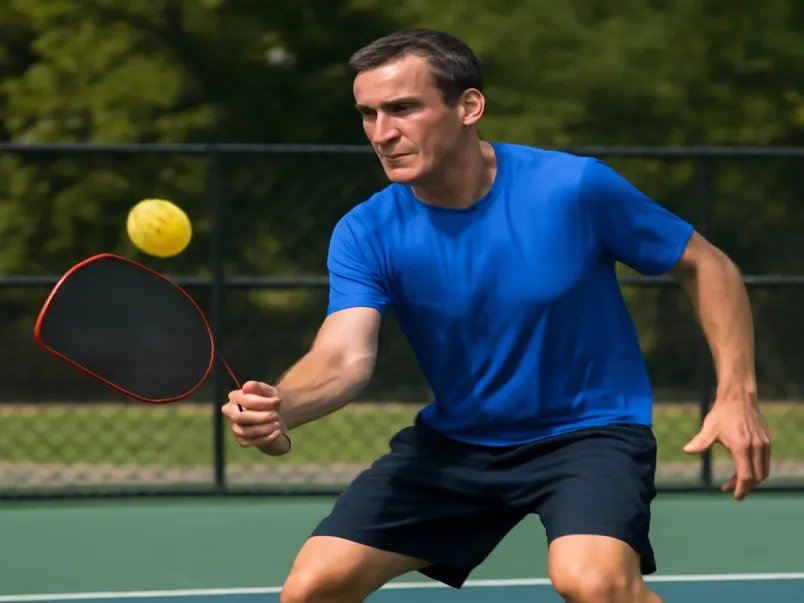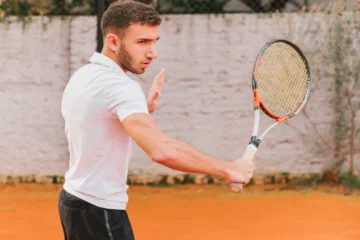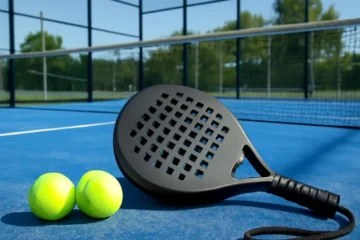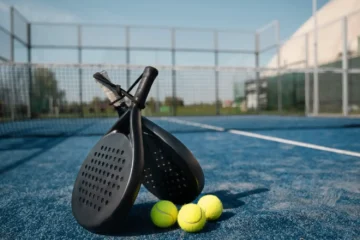In pickleball, players often face a choice when a medium-paced ball comes to their forehand in the transition zone (also known as the mid-court area). Do you dink, drive, or is there a better, more aggressive option? One of the most potent shots you can add to your arsenal is the Vibora—a shot that blends power, spin, and precision. In this ultimate guide, we’ll break down everything you need to know about the Vibora shot—from its definition and mechanics to its strategic use in high-pressure situations.
What is the Vibora Shot?
The Vibora shot in pickleball is often described as a hybrid between a drive and a topspin roll. Unlike a regular drive, which is flatter and faster, the Vibora generates more spin, creating a higher arc and slower, more controlled pace. This shot is executed with a low-to-high brushing motion that adds a significant amount of topspin, making it a formidable weapon for attacking balls in the mid-court.
The name “Vibora” is derived from the Spanish word for “viper,” referencing the shot’s sharp, biting, and unpredictable nature, much like the sudden strike of a viper. This shot is especially effective in forcing weak returns from opponents and can change the momentum of a rally when used at the right time.
Why Master the Vibora Shot?
The Vibora shot is not just for aggressive players but can be an essential tactic for intermediate and advanced players who want to elevate their game. Mastering this shot adds depth and versatility to your play, particularly in the transition zone where many rallies are decided. Not only does it put pressure on your opponents, but it also opens up the court by pushing them back, allowing you to control the pace of the game.
The Anatomy of the Vibora Shot
The Grip
To start, the ideal grip for hitting a Vibora shot is a continental grip or an eastern forehand grip. The continental grip is versatile, allowing you to make adjustments during play and generate the wrist snap necessary for topspin. The eastern grip, on the other hand, offers more control over the ball’s spin and trajectory.
The Stance and Preparation
- Athletic Stance: To execute a Vibora shot, start by positioning your feet about shoulder-width apart. Keep your knees bent, and stay low to maintain balance and agility.
- Early Paddle Preparation: As the ball approaches, prepare your paddle early by taking it low and back. This sets you up for a clean, controlled hit.
The Swing and Contact
- Low-to-High Brushing Motion: The key motion in the Vibora is a low-to-high brush against the back of the ball. This brushing action generates topspin and creates a more arcing ball flight.
- Snap the Wrist: To maximize topspin, focus on pronating and snapping your wrist at the point of contact. This quick wrist action ensures that the ball dips and stays within the court boundaries.
- Contact Point: Hit the ball slightly in front of your body at about waist height. This gives you better control over the shot and allows for efficient energy transfer.
The Follow-Through
A full, upward follow-through across your body is essential for maintaining control over the shot. The follow-through also helps generate the topspin required to make the ball dip quickly. Finish high, with your paddle ideally above your head, to ensure a clean and controlled shot.
When to Use the Vibora Shot
The Ideal Scenario
The Vibora is particularly effective when attacking a medium-paced, medium-height ball in the transition zone. The transition zone is the area between the baseline and the kitchen (the non-volley zone). The kitchen is too close for a drive, and the baseline is too far for a dink, making the transition zone the perfect place for a Vibora shot.
Specific Situations to Use the Vibora
- Against a Soft Third Shot: If your opponent hits a weak third-shot drop, you have an excellent opportunity to use the Vibora to attack and put pressure on them.
- Returning a Dink: When your opponent’s dink pops up a few inches too high, the Vibora can punish the mistake with heavy topspin and controlled pace.
- As a Fifth Shot: After you’ve executed a successful third-shot drop, if your opponent returns it short, the Vibora is an excellent choice for a fifth-shot follow-up.
- Against Bangers: If you’re up against a player who hits hard (a “banger”), you can use their pace against them by adding your own topspin for a controlled counter-attack.
Strategic Advantages of the Vibora
The Vibora is more than just a pretty shot—it’s a powerful tool in your pickleball arsenal for several reasons:
1. Heavy Topspin
The topspin generated by the Vibora causes the ball to dip quickly, making it difficult for your opponent to volley. It forces a groundstroke return, which is often easier to control and puts you in a favorable position for the next shot.
2. Creates an Uncomfortable Ball
The combination of pace and topspin makes the Vibora a very uncomfortable ball to return. Opponents are often forced into making errors or weak returns because of the dip and unpredictable bounce.
3. Maintains Offensive Pressure
While a drive is often a higher-risk shot, the Vibora allows you to apply pressure with less risk of sailing the ball long. Its higher arc and topspin make it easier to control while still being aggressive.
4. Opens Up the Court
The topspin on the Vibora can push your opponents back, creating space on the court. This opens up opportunities for you to hit a winning shot or dictate the pace of the rally.
Common Mistakes to Avoid
Mastering the Vibora requires practice, and even seasoned players can make mistakes. Here are some common pitfalls to watch out for:
1. Swinging Too Flat
If you swing too flat, you risk hitting the net or sending the ball long. The Vibora relies on topspin, so make sure to focus on the low-to-high motion to generate the necessary spin.
2. Using It at the Wrong Time
The Vibora is an offensive shot, and it’s crucial to use it in the right situations. Hitting a Vibora when the ball is too low or too high can result in ineffective shots. Always look for a medium-height ball for the best results.
3. Over-Hitting the Shot
The Vibora is about pressure, not necessarily about hitting a winner. Trying to hit the ball too hard can result in errors or a ball that goes out. Aim for controlled aggression and focus on consistency.
4. Telegraphing the Shot
Avoid making an overly dramatic wind-up before executing the Vibora. If your opponents can read your intentions, they may be able to anticipate and counter the shot.
Drills to Master the Vibora Shot
To really master the Vibora, you need consistent practice. Here are a few drills that will help you improve your technique and timing:
1. The “Brush-Up” Drill
This drill helps you focus on the brushing motion necessary to generate topspin. Stand close to a wall and practice hitting the ball with a low-to-high motion, paying attention to the spin rather than power. This will help develop the feel for the Vibora.
2. The Transition Zone Drill
Have a partner feed you medium-height balls in the transition zone. Your only options are to hit a Vibora or a reset drop shot. This drill forces you to make quick decisions and execute the Vibora under pressure.
3. Live-Point Practice
One of the best ways to get comfortable with the Vibora is to incorporate it into live-point play. Challenge yourself to look for at least one Vibora opportunity per point. The more you practice in a real-game setting, the more natural the shot will feel.
Conclusion: Adding the Bite to Your Game
Incorporating the Vibora shot into your game can be a game-changer. It’s a controlled, aggressive topspin shot that can put pressure on your opponents, force weak returns, and open up the court for your next move. While mastering the Vibora requires practice, it’s a shot that can take your game from intermediate to advanced.
FAQs About the Vibora Shot in Pickleball
1. What is a Vibora shot in pickleball?
The Vibora is a hybrid shot that combines the power of a drive with the spin of a topspin roll. It is executed with a low-to-high brushing motion, generating significant topspin to attack a medium-paced ball, typically from the mid-court or transition zone.
2. How does the Vibora differ from a drive or a third-shot drop?
The Vibora has more spin and arc than a traditional drive, making it a higher-percentage shot with better control. Unlike the soft third-shot drop that resets the point, the Vibora is an offensive shot designed to put pressure on your opponent and create weak returns.
3. When is the best time to use the Vibora shot?
The Vibora is most effective when attacking a medium-paced ball in the transition zone (mid-court), especially against a weak third-shot drop, returning a high dink, or after hitting a third-shot drop that your opponent returns short.
4. What mistakes should I avoid when using the Vibora shot?
Common mistakes include swinging too flat, using the Vibora at the wrong time (on a ball that’s too high or too low), over-hitting the shot, and telegraphing your intentions with a dramatic wind-up.
5. How can I practice the Vibora shot?
Drills like the “Brush-Up” drill, the “Transition Zone” drill, and live-point practice can help you master the Vibora. Focus on generating heavy topspin, making quick decisions, and committing to looking for Vibora opportunities during games.
6. What grip should I use for the Vibora shot?
The continental or eastern forehand grip is recommended. The continental grip offers versatility, while the eastern grip helps you generate more spin and control over the ball.




